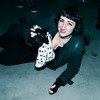
Advertisement

Hassan Hajjaj: I've been working in this way for years now. I want to show something particular to Marrakesh, and to show that even though we have different cultures and religions; we share a lot in common as people. There is a group of women who work painting henna in this main square in Morocco that is popular with tourists. One I know was an inspiration for this series, Karima, she wears a veil and these really amazing textile abayas and djabellas and also rides a bike to work and back, she's a normal woman who works eight or ten hours a day. She speaks about four or five languages, is a housewife to two kids, [and] built her own house.

I was working on a fashion magazine photo shoot in Marrakesh in the 1990s when I realized everything—all the models, the photographer, the clothes—were from the west and Morocco was simply the backdrop. From then I said it'd be great to present my people in their environment in their kind of way of dressing, and play with it on a fashion level.What is the bike culture like in Marrakech? Generally speaking, do bike gangs even exist there? How big are motorbikes?
Marrakech is really a bike city; everyone rides them. Women, kids, old men, families, everybody. It's transportation; it's really used for work. A few of the bikes in the photos are from friends of mine we borrowed, but most are their own bikes. There are no real bike gangs.
Advertisement

Moroccans have a strong sense of tradition and we are a very colorful nation. But I design the outfits: These traditional Moroccan djabellas and abayas and babouche with traditional prints and knock-off brand-name fabrics from markets in London and Marrakesh. I also build the frames for the photographs using products or objects I find in markets: cans of Fanta, tins, or boxes of chicken stock. This came from when I was growing up in Morocco as many things are recycled to be re-used, and this has somehow come into my work. I wanted to use the repetition of labels in a slightly humorous context, often directly relating to something happening in the photograph, but I also wanted to create a repeated pattern in the frame to evoke the mosaics of Morocco in a modern context.What was the goal of this shoot and what was the best moment of shooting this series?
I'm impressed with their strength and really aim to show their independence as normal. If these photos were taken in Paris or Rome I imagine I wouldn't be asked what is so unique about women’s biker culture.If you had a bike gang who would be in it?
My gang would include women like you see in this series; women who just naturally have this strength, swagger, freedom.See all more of the photos below:






